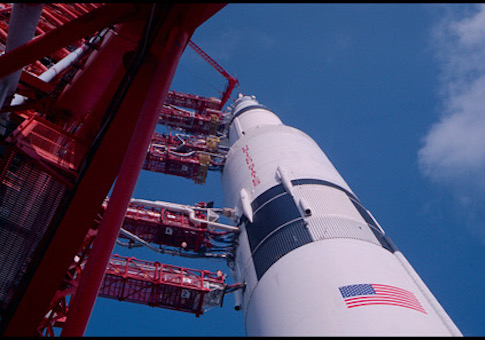Apollo 11 is a fully immersive experience. The movie showcases some of the large-format footage of the mission that was shot by top cinematographers but which, for 50 years, was only shown in cropped formats, when any of it was shown at all. More than 60 high-definition, unfaded reels sat forgotten for nearly five decades until the National Archives and Records Administration's Dan Rooney went through them doing research for the movie. In the hands of director Todd Douglas Miller and his team, those reels provided the material for what is no less than the definitive motion-picture account of the mission that sent the first men to the moon.
The film, which is in IMAX theaters for one week and in regular theaters afterward, starts with the behemoth crawler-transporter slowly carrying the Saturn V rocket to its launchpad. Soon, viewers are looking back at the Merritt Island launch site from inside a helicopter. The rocket is fully in view, the sound of the chopper thumps in your ears, and it's established that the movie is a window into history rather than a normal documentary. No talking heads or narrators explain what is happening. Instead, NASA diagrams and audio transmissions—often synced with video of the person speaking—provide further details while viewers soak up the awe-inspiring images of Earth, space, and the surface of another world.
The effect is closer to Hollywood films like 2001: A Space Odyssey or Dunkirk than to a standard historical account. Indeed, Miller said one of the Mitchell 65mm, 5-perforation cameras that captured the footage was likely used in the production of 2001. (Beyond creating a film, part of this project has been documenting what was found for future use.) Having enough video and audio footage to cover the whole mission enabled the filmmakers to stick with a cinéma vérité style without sacrificing narrative coherence. Everything unfolds as if you're there, jumping from place to place to see the constituent parts in motion.
Apollo 11 approximates real time by keeping the countdown clock in view and showing engineers, controllers, and even the astronauts themselves prepping at a deliberate pace. No one is in a rush. But the sense of anticipation permeates everything, from the three spacefarers suiting up to a multitude of onlookers patiently waiting in a J.C. Penney parking lot, ready to see history unfold.
The anticipation pays off spectacularly. In an IMAX theater, the thunderous launch is awe-inspiring. But it's not just the sound and picture, it's also the details that were captured. You can see the airborne Saturn V rocket reflected in the sunglasses of spectators. In space, the movie doesn't just show the dramatic landing, the first steps, and the planting of the flag—it also shows astronauts saying goodnight to Mission Control, listening to music, and calmly going about their business.
The footage from the moon's surface will be familiar to most, especially to those of us who have spent hours upon hours at the Smithsonian's Air and Space Museum. But even the well-known images are presented in far greater detail than most have ever seen them. The radio transmissions sadly lack the crispness of the images, yet most of the information they convey is not critical to understanding the movie. A viewer that tunes out for periods won't miss too much. The chatter provides ambiance and brings to the forefront how low-tech many of their tools were compared with today's. Charming details, such as a short conversation about Ted Kennedy's car wreck in Chappaquiddick, personalize the moment. The filmmakers even discovered the astronauts playing a tape of "Mother Country" by their friend, singer-songwriter John Stewart. The faint audio transitions into the actual song, which was happily allowed onto the soundtrack by Stewart's widow Buffy Ford Stewart.
A word about the score. As the most direct way the filmmakers imposed their own vision onto the story, the score plays a special role in Apollo 11, and composer Matt Morton knocks it out of the park. Previously, he's scored Miller's films in a classical mode, but for Apollo 11 he dove into the synthesizer music of the era and got his own 1968 Moog Synthesizer IIIc with which to make compositions. The music doesn't take center stage, but it does administer a shot of retro-futurism, locating the mission in the 1960s and enhancing its otherworldliness.
Fifty years after the event is the perfect time for this movie to come out. America in 1969 has a touch of the exotic but is still familiar. Apollo 11 is nostalgia as well as adventure: a blast of Americana that culminates in a trip beyond Earth.
